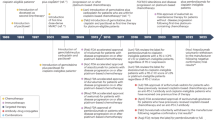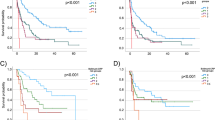Abstract
There have been no major advances for the treatment of metastatic urothelial bladder cancer (UBC) in the last 30 years. Chemotherapy is still the standard of care. Patient outcomes, especially for those in whom chemotherapy is not effective or is poorly tolerated, remain poor1,2. One hallmark of UBC is the presence of high rates of somatic mutations3,4,5. These alterations may enhance the ability of the host immune system to recognize tumour cells as foreign owing to an increased number of antigens6. However, these cancers may also elude immune surveillance and eradication through the expression of programmed death-ligand 1 (PD-L1; also called CD274 or B7-H1) in the tumour microenvironment7,8. Therefore, we examined the anti-PD-L1 antibody MPDL3280A, a systemic cancer immunotherapy, for the treatment of metastatic UBC. MPDL3280A is a high-affinity engineered human anti-PD-L1 monoclonal immunoglobulin-G1 antibody that inhibits the interaction of PD-L1 with PD-1 (PDCD1) and B7.1 (CD80)9. Because PD-L1 is expressed on activated T cells, MPDL3280A was engineered with a modification in the Fc domain that eliminates antibody-dependent cellular cytotoxicity at clinically relevant doses to prevent the depletion of T cells expressing PD-L1. Here we show that MPDL3280A has noteworthy activity in metastatic UBC. Responses were often rapid, with many occurring at the time of the first response assessment (6 weeks) and nearly all were ongoing at the data cutoff. This phase I expansion study, with an adaptive design that allowed for biomarker-positive enriched cohorts, demonstrated that tumours expressing PD-L1-positive tumour-infiltrating immune cells had particularly high response rates. Moreover, owing to the favourable toxicity profile, including a lack of renal toxicity, patients with UBC, who are often older and have a higher incidence of renal impairment, may be better able to tolerate MPDL3280A versus chemotherapy. These results suggest that MPDL3280A may have an important role in treating UBC—the drug received breakthrough designation status by the US Food and Drug Administration (FDA) in June 2014.
This is a preview of subscription content, access via your institution
Access options
Subscribe to this journal
Receive 51 print issues and online access
$199.00 per year
only $3.90 per issue
Buy this article
- Purchase on Springer Link
- Instant access to full article PDF
Prices may be subject to local taxes which are calculated during checkout


Similar content being viewed by others
References
Choueiri, T. K. et al. Double-blind, randomized trial of docetaxel plus vandetanib versus docetaxel plus placebo in platinum-pretreated metastatic urothelial cancer. J. Clin. Oncol. 30, 507–512 (2012)
Bellmunt, J. et al. Phase III trial of vinflunine plus best supportive care compared with best supportive care alone after a platinum-containing regimen in patients with advanced transitional cell carcinoma of the urothelial tract. J. Clin. Oncol. 27, 4454–4461 (2009)
Cancer Genome Atlas Research Network. Comprehensive molecular characterization of urothelial bladder carcinoma. Nature 507, 315–322 (2014)
Lawrence, M. S. et al. Mutational heterogeneity in cancer and the search for new cancer-associated genes. Nature 499, 214–218 (2013)
Kandoth, C. et al. Mutational landscape and significance across 12 major cancer types. Nature 502, 333–339 (2013)
Chen, D. S. & Mellman, I. Oncology meets immunology: the cancer-immunity cycle. Immunity 39, 1–10 (2013)
Chen, D. S., Irving, B. A. & Hodi, F. S. Molecular pathways: next-generation immunotherapy—inhibiting programmed death-ligand 1 and programmed death-1. Clin. Cancer Res. 18, 6580–6587 (2012)
van Rooij, N. et al. Tumor exome analysis reveals neoantigen-specific T-cell reactivity in an ipilimumab-responsive melanoma. J. Clin. Oncol. 31, e439–e442 (2013)
Herbst, R. S. et al. Predictive correlates of response to anti-PD-L1 in cancer patients. Nature http://dx.doi.org/10.1038/nature14011 (this issue)
Topalian, S. L. et al. Safety, activity, and immune correlates of anti-PD-1 antibody in cancer. N. Engl. J. Med. 366, 2443–2454 (2012)
Bellmunt, J. et al. Prognostic factors in patients with advanced transitional cell carcinoma of the urothelial tract experiencing treatment failure with platinum-containing regimens. J. Clin. Oncol. 28, 1850–1855 (2010)
Sonpavde, G. et al. Time from prior chemotherapy enhances prognostic risk grouping in the second-line setting of advanced urothelial carcinoma: a retrospective analysis of pooled, prospective phase 2 trials. Eur. Urol. 63, 717–723 (2013)
Wrammert, J. et al. Rapid cloning of high-affinity human monoclonal antibodies against influenza virus. Nature 453, 667–671 (2008)
De Santis, M. et al. Randomized phase II/III trial assessing gemcitabine/carboplatin and methotrexate/carboplatin/vinblastine in patients with advanced urothelial cancer who are unfit for cisplatin-based chemotherapy: EORTC study 30986. J. Clin. Oncol. 30, 191–199 (2012)
Dreicer, R., Gustin, D. M., See, W. A. & Williams, R. D. Paclitaxel in advanced urothelial carcinoma: its role in patients with renal insufficiency and as salvage therapy. J. Urol. 156, 1606–1608 (1996)
Gallagher, D. J. et al. Phase II study of sunitinib in patients with metastatic urothelial cancer. J. Clin. Oncol. 28, 1373–1379 (2010)
Necchi, A. et al. Pazopanib in advanced and platinum-resistant urothelial cancer: an open-label, single group, phase 2 trial. Lancet Oncol. 13, 810–816 (2012)
Seront, E. et al. Phase II study of everolimus in patients with locally advanced or metastatic transitional cell carcinoma of the urothelial tract: clinical activity, molecular response, and biomarkers. Ann. Oncol. 23, 2663–2670 (2012)
Vaughn, D. J. et al. Vinflunine in platinum-pretreated patients with locally advanced or metastatic urothelial carcinoma: results of a large phase 2 study. Cancer 115, 4110–4117 (2009)
Sweeney, C. J. et al. Phase II study of pemetrexed for second-line treatment of transitional cell cancer of the urothelium. J. Clin. Oncol. 24, 3451–3457 (2006)
Ko, Y. J. et al. Nanoparticle albumin-bound paclitaxel for second-line treatment of metastatic urothelial carcinoma: a single group, multicentre, phase 2 study. Lancet Oncol. 14, 769–776 (2013)
Culine, S. et al. A phase II study of vinflunine in bladder cancer patients progressing after first-line platinum-containing regimen. Br. J. Cancer 94, 1395–1401 (2006)
Chen, G. J., Galsky, M. D., Latini, D. M., Sonpavde, G. & DeBakey, M. E. Patterns of chemotherapy and survival in elderly patients with advanced bladder cancer: a large Medicare database study. J. Clin. Oncol. (suppl.) abstr. 4551. (2013)
Okamura, H. et al. Cloning of a new cytokine that induces IFN-γ production by T cells. Nature 378, 88–91 (1995)
Iwai, Y. et al. An IFN-γ-IL-18 signaling loop accelerates memory CD8+ T cell proliferation. PLoS ONE 3, e2404 (2008)
Topalian, S. L. et al. Safety, activity, and immune correlates of anti-PD-1 antibody in cancer. N. Engl. J. Med. 366, 2443–2454 (2012)
Dahlberg, S. E., Shapiro, G. I., Clark, J. W. & Johnson, B. E. Evaluation of statistical designs in phase I expansion cohorts: the Dana-Farber/Harvard Cancer Center experience. J. Natl Cancer Inst. 106, dju163 (2014)
Wolchok, J. D. et al. Guidelines for the evaluation of immune therapy activity in solid tumors: immune-related response criteria. Clin. Cancer Res. 15, 7412–7420 (2009)
Eisenhauer, E. A. et al. New response evaluation criteria in solid tumours: revised RECIST guideline (version 1.1). Eur. J. Cancer 45, 228–247 (2009)
Acknowledgements
We thank the patients and their families. Additionally, we thank the investigators and their staff, including the Barts Health NHS Trust and the Royal Free Foundation Trust, A. Balmanoukian and O. Hamid (The Angeles Clinic and Research Institute), J. Powderly (Carolina BioOncology Institute), P. Cassier (Centre Léon-Bérard), F. Steven Hodi (Dana-Farber Cancer Institute), J.-C. Soria (Gustave Roussy), J. P. DeLord (Institute Claudius Regaud), C. Drake and L. Emens (Johns Hopkins), D. Lawrence and R. Lee (Massachusetts General Hospital), S. Antonia and J. Zhang (Moffitt Cancer Center), M. Gordon (Pinnacle Oncology Hematology), H. Kohrt and S. Srinivas (Stanford University Cancer Institute), and J. Tabernero (Vall d'Hebron University Hospital). Support for third-party writing assistance for this manuscript was provided by F. Hoffmann-La Roche Ltd.
Author information
Authors and Affiliations
Contributions
T.P., G.D.F., D.P.P., D.S.C. and N.J.V. contributed to the overall study design; Z.B. and P.S.H. provided the biomarker studies; S.-l.T. performed the statistical analysis. All authors analysed the data. All authors contributed to writing the paper.
Corresponding author
Ethics declarations
Competing interests
T.P., consultant/advisory for GlaxoSmithKline, Genentech; F.S.B., speaker and advisory for Inctye; consultant/advisory for BMS; Research funding from Roche; Y.L., Research grants from Astellas, Sanofi; consultant for Astellas, Sanofi, Cellgen, Pierre Fabre; J.B., uncompensated consultant/advisory for Genentech; N.J.V., consultant to Roche/Genentech; G.D.F., S.-l.T., X.S., Z.B., P.S.H. and D.S.C. are employees of Genentech. C.C., D.P.P., H.A.B. and J.P.E. have no disclosures.
Extended data figures and tables
Extended Data Figure 1 Time between tissue collection and starting MPDL3280A.
A histogram depicting the length of time between the collection of tissue samples used in biomarker analyses and cycle 1, day 1 of a patient’s course of treatment with MPDL3280A.
Extended Data Figure 2 A patient with a complete response to MPDL3280A.
a, Example of PD-L1 staining within the patient’s tumour at baseline (×20 magnification). Several clusters of PD-L1-negative tumour cells are seen within a stroma densely infiltrated by immune cells. Staining for PD-L1 is observed in tumour-infiltrating immune cells in the form of variably sized clusters or single scattered cells. The morphology of PD-L1-positive tumour-infiltrating immune cells ranges from small lymphoid cells to larger cells with more abundant cytoplasm. b, The patient’s circulating tumour cells had dropped from 104 to 0 by cycle 3 corresponding with the change in the SLD. This patient had ≤100% reduction of the target lesions due to lymph node target lesions and his lymph nodes returned to normal size as per Response Evaluation Criteria in Solid Tumours v1.1. CTC, circulating tumour cells; SLD, sum of the longest diameters; WB, whole blood.
Extended Data Figure 3 Pharmacodynamic markers of MPDL3280A activity.
Graphs depicting IFN-γ (n = 53), IL-18 (n = 61) and CD3+CD8+HLA-DR+Ki-67+ T-cell levels (n = 59) over cycles (C) and days (D) of treatment with MPDL3280A. Data range (95% confidence interval) is indicated in light blue. FC, fold change.
PowerPoint slides
Rights and permissions
About this article
Cite this article
Powles, T., Eder, J., Fine, G. et al. MPDL3280A (anti-PD-L1) treatment leads to clinical activity in metastatic bladder cancer. Nature 515, 558–562 (2014). https://doi.org/10.1038/nature13904
Received:
Accepted:
Published:
Issue Date:
DOI: https://doi.org/10.1038/nature13904
This article is cited by
-
Progress in systemic therapy for advanced-stage urothelial carcinoma
Nature Reviews Clinical Oncology (2024)
-
Dendritic cells as orchestrators of anticancer immunity and immunotherapy
Nature Reviews Clinical Oncology (2024)
-
INDUCE-2: A Phase I/II, open-label, two-part study of feladilimab in combination with tremelimumab in patients with advanced solid tumors
Cancer Immunology, Immunotherapy (2024)
-
Clinical immunotherapy in pancreatic cancer
Cancer Immunology, Immunotherapy (2024)
-
Integrative analysis of a novel super-enhancer-associated lncRNA prognostic signature and identifying LINC00945 in aggravating glioma progression
Human Genomics (2023)
Comments
By submitting a comment you agree to abide by our Terms and Community Guidelines. If you find something abusive or that does not comply with our terms or guidelines please flag it as inappropriate.



